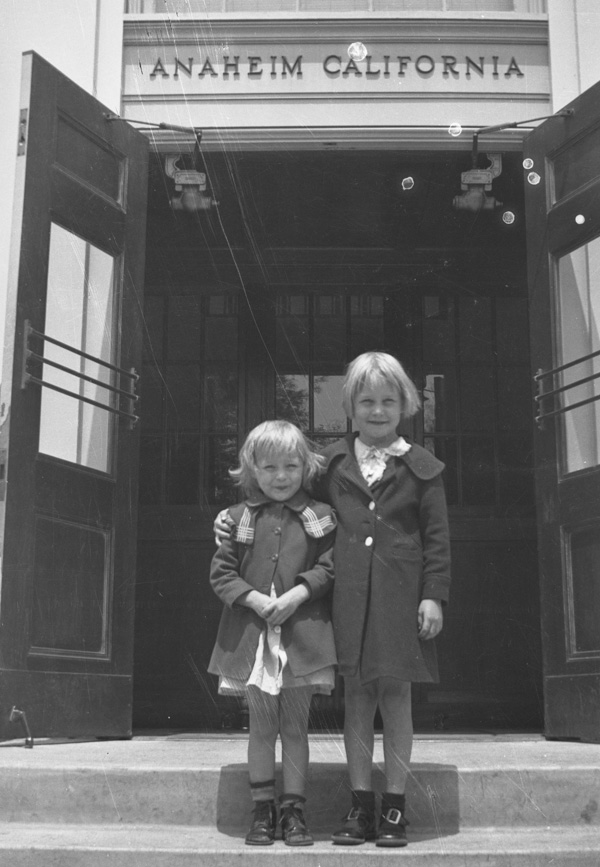
Old film can get pretty grubby. At the least, loose negatives are often dusty and smudged. Inquiring minds wanted to know if do-it-yourself film cleaners made a difference, and how well they worked with dirty old negatives. So, The Family Curator burned up $20 so you don’t have to.
First, I talked with photographers about cleaning old negatives. Their reply was something like, “Why bother? Fix it in Photoshop.”
Next, I went to a pro camera store and talked with the developing tech. She recommended a product called, appropriately enough, Delta Film Cleaner, and PEC Pads, lint-free cleaning cloths. Another product, PEC-12, was deemed too caustic for amateurs to use (hmmm). I was instructed to lightly spray the cleaner on the cloth and wipe gently across the surface of the film. Sounds simple enough.
At home, I pulled out an assortment of dirty, crinkled, stained, torn, cut, and otherwise messed up black and white negatives and selected a few with typical damage: water stains, ink, and splotches of “crud.”
I thought the lumpy gunk was just, well, gunk, but the photo tech had warned me that “stuff” on the surface of the film was probably fungus growing into the emulsion and it would not come off the negative. The cleaner would only help with dirt, dust, and spots.
My negatives had it all — water stains, ink, gunk, dust, and general grime.
Test 1 — Using Film Cleaner to Clean Old Negatives
Damage: This negative showed bits of gunk (they appear as white dots in the image below), general grime, and scratches.
Process: I spread out a few sheets of clean paper on my kitchen counter and sprayed the Film Cleaner on the lint-free cloth. Then, I gently wiped once across both front and back of the film. You can see the results here.
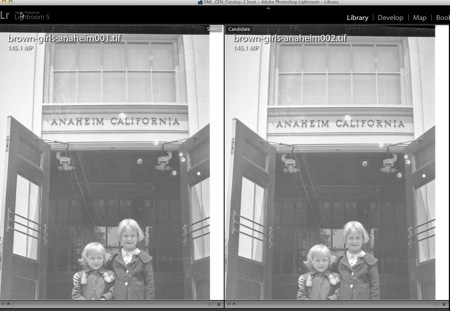
Uncleaned negative (left) vs. cleaned negative (right)
Results: The little spots over the doorway are gunk, that won’t come off. The film is marred with scratches obvious in the upper left corner of the doorway; the cleaner doesn’t help that. It’s hard to see on this image, but the cleaned negative (right) yielded a digital image with a bit of more grey tint. The image does seem a bit brighter. I did not use any adjustments on the scan.
Comments: This image adjustment is easy with photo editing software. No major improvement in overall quality.
BOTTOM LINE: Not worth the trouble.
Test 2 — Using Water to Clean Old Negatives
Damage: This negative showed a big blotch, possibly a water stain, in the upper right hand corner of sky. There were also bits of gunk in the tree area, and general dirt and grime on the entire image
Process: I held the negative under warm running water using my fingers like a squeegee to move the water and saturate the film. I then used the lint-free cloths to wipe off excess water and placed the negative on top of a cloth for a few minutes. Next, I sprayed the Film Cleaner on a cloth and gently wiped the surface of the film to remove any water spots.
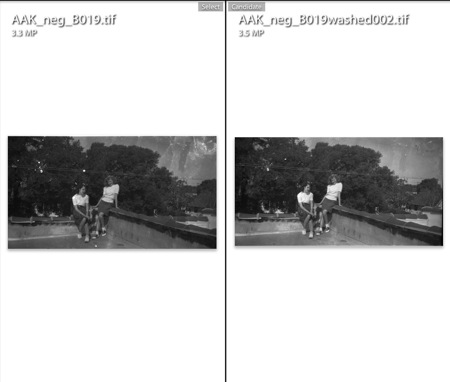
Original dirty negative (left) and negative washed with warm water and Film Cleaner (right).
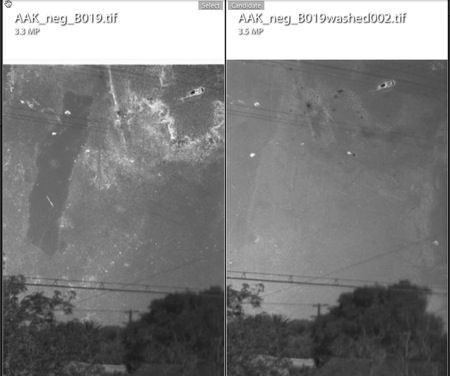
Close up of “gunk” in sky. Washed film is better, but remains stained.
Results: The cloth showed dirt blotches and the film felt clean, not dusty and dirty. Most of the stain in the trees diminished. The entire image is brighter.
Comments: I could touch up the sky with software, but now the film is “nice and clean.” It might not look this good when enlarged, however.
BOTTOM LINE: Probably not worth the trouble and expense.
Postscript
My main interest in old film is to salvage the family history information it may hold. For that purpose, scanned copies of the negative meets my needs. I don’t throw away the original negative, but I also don’t feel compelled to return the film to pristine condition before storing in archival sleeves.
Admittedly, my experiment in film cleaning was not conducted under scientific conditions. My kitchen is pretty clean, but it’s not completely dust-proof. If a house has static electricity from dry air or wind, exposed negatives probably attract everything floating around the room and cleaning might be even more difficult.
I think a better, easier solution for working with dirty old film might be to use a soft brush made for dusting film and save the Film Cleaner for cleaning negatives that you want specifically want to preserve in analog (film) format. Clean film has to have a longer lifespan than dirty old pictures.
The products I used for this test included:
P.P.S. I am an Amazon Affiliate


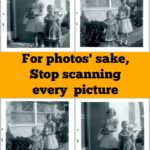



Thanks for doing this research. I'll follow your advice and not spend the time and effort. Love the picture of the girls!
Wow, I'm sorry to hear about your slides, Anne. I won't try that one! Thank you for sharing your own results too. I'm glad you found the review helpful.
I tried cleaning a couple of expendable old slides with PEC-12 and Q-tips and PEC Pads and lost the images. Glad they were expendable! However I have only used water on a few old negatives. I agree with you that it is not worth time and effort when Photoshop can do the job. Thanks for the test and your results–very informative.